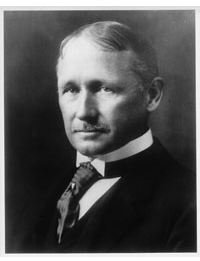The History of Project Management: Frederick Taylor and 19th Century Business Ideas
Long Before Microsoft Project…
Long before Microsoft Project and the rest of our favorite tools codified the world of the professional project managers, organizational leaders had little choice but to follow a single kind of project management principle:
They had to wing it.
Although it seems absurd to think that some of the most complex architectural and military achievements of history happened without Gantt charts, very few leaders had the resources and the insight to focus on the process of project management until very late in the nineteenth century. As modern cities emerged and businesses started to take on identities and life spans beyond those of their owners, company leaders eagerly anticipated a world where Dickensian brute labor could be refined by understanding how to help workers become more efficient.
Frederick Taylor: The First Project Management Consultant
Philadelphia native Frederick Winslow Taylor is considered by many historians to be the first scholar of modern business. Originally destined for a career in law, Taylor suffered vision problems that forced him to abandon Harvard in favor of an industrial career. Over the years, he moved up the early corporate ladder, ultimately earning the post of General Manager at the Manufacturing Investment Company.
Taylor’s unusual methods often brought him into conflict with managers and shareholders. After only a few years at the helm of M.I.C., he launched his own management consulting practice. From his office in Philadelphia, Taylor consulted with some of the biggest corporations of his day, including the forerunners of today’s largest companies. Like many of today’s most respected project managers, he developed his academic credentials by enrolling in evening courses at a respected career training school. Today, his alma mater, the Stevens Institute of Technology, hosts a special collection of Taylor’s archives in its S.C. Williams Library.
Aiming for Above Average
Throughout his career, Taylor used the same dedication to documentation from his early law studies to uncover patterns of worker behavior. By adapting slide rules, stopwatches, and other common tools to his purpose, Taylor and his team investigated the habits of steel workers, mill workers, and other industrial laborers. With that data, Taylor intended to document evidence of peak performance. With this data, Taylor’s companies could streamline production, schedule deliveries of raw materials, and make more accurate estimates of production time.
Frederick Taylor
Keeping 19th Century Laborers On Time and On Task
Taylor was among the first business leaders to start documenting labor processes based on time and relationships. While working with Bethlehem Steel, Taylor discovered that limiting shovel loads of raw material to 21 1/2 pounds produced the most efficient results. Instead of requiring workers to guess the weight of their loads, Taylor commissioned special shovels that held exactly that much weight. Although frustrated managers at the steel plant arranged for Taylor’s dismissal, this concept has since influenced everything from auto manufacturing to restaurant kitchen design. Reflecting the tone of his era, Taylor often wrote of his frustrations with laborers and with managers. Believing many laborers too stupid to comprehend his ideas and many managers too cowardly to enforce them, Taylor’s writing grew more polarizing over the years.
Peak Performance and the Downfall of Taylorism
Today, business school professors still assign readings from Taylor’s groundbreaking final book, <em>Principles of Scientific Management</em>. According to business historians, Taylor was the first business leader to introduce three core principles of project management and leadership that we still use today under the names:
• Work out
Throughout his writing and consulting, Taylor emphasized the benefits of standardized processes and measured performance. While not framing his ideas as specifically against organized labor, Taylor often noted that firms who applied his principles would effectively negate the need for unions by offering shorter workweeks and larger salaries.
Corporate and government leaders latched on to Taylor’s ideas, especially since they appeared to apply scientific techniques to the measurement of individual performance. Unfortunately, leaders taking Taylor’s principles to the extreme often created untenable working conditions for laborers, who struggled to meet the rigid goals set by shop bosses.
Colleagues of Taylor’s ultimately revealed that their measurements of human output were often adjusted by as much as a third to accommodate the differences between individuals. Without today’s technology to measure the minute details of a worker’s day, researchers on Taylor’s teams used their best guesses to set production goals for their client companies.
Disappointed in the inability of Taylorism to deliver its promised results, business leaders shunned Taylor, who died in 1915. However, scholars and managers influenced by Taylor’s core ideas would revolutionize business over the following decades, specifically by developing his nascent project management principles. One innovation in particular would change the role of managers in organizations forever…
Read on to part 2 of this series to find out more.
This post is part of the series: The History of Project Management
Five key periods in the evolution of project management practices and principles.
- The History of Project Management: Frederick Taylor and 19th Century Peak Performance
- The History of Project Management: Gantt and the Early 20th Century
- The History of Project Management: Change Through the 1950s
- The History of Project Management: Late 20th Century Process and Improvements
- The History of Project Management: Into the 21st Century
